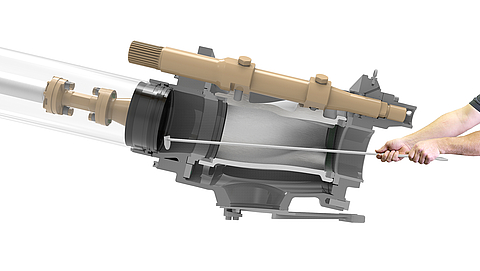ROCK valve
The most important component of a two-piston concrete pump is the concrete valve. Under high pressure, it switches between the two delivery cylinders and ensures that the flow of concrete from the delivery cylinders into the outlet is as friction-free as possible. With the unique ROCK valve, all concrete pumps from SCHWING have a concrete valve, which is characterized by extremely low wear, a long service life and a very good cleaning ability. Developed by SCHWING on the basis of the negative experiences with the S-pipe also developed by SCHWING and put on the market in 1983, it is still the benchmark for economic efficiency and robustness.
Low wear
In the concrete valve, the wear is particularly high, because here the concrete is passed under high pressure into the outlet. To minimize this wear, the ROCK at the most heavily loaded point, unlike other concrete valves, does not encounter concrete on steel but concrete on concrete. Thanks to the intelligent design of the ROCK, a concrete triangle builds up again after each swiveling, at which the delivery stream slides along with little wear. Protected by this concrete layer, the ROCK has a significantly longer service life than other concrete valves.
Fast cleaning
Thanks to its straight design, the ROCK valve is much easier and faster to clean than other concrete valves. Because it allows a direct view into the delivery cylinder and on the delivery pistons and allows the removal of the residual concrete with the scratch from the ROCK. Subsequently, the pump battery can be easily and conveniently cleaned within only two strokes. This saves water and reduces the unproductive cleaning time.
Easy maintenance
The number of wear parts is significantly lower for the ROCK valve due to its design than other concrete valves. At the same time, the wear parts can be replaced faster and easier by dismantling the housing cover. In combination with the generally lower wear of the ROCK, this leads to a noticeably higher availability of the concrete pump and lower maintenance costs.











